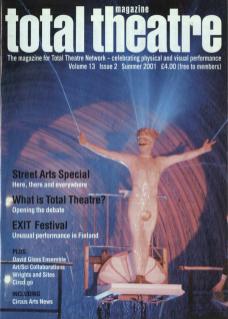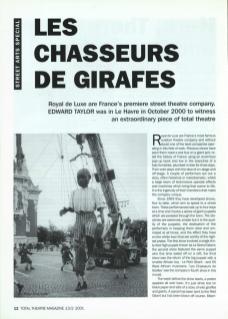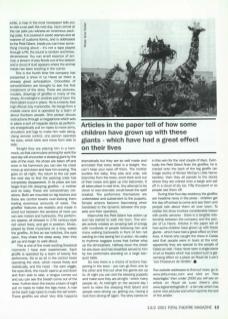Royal de Luxe are France's most famous outdoor theatre company and without doubt one of the best companies operating in this field of work. Previous shows have seen them roast a real bus on a giant spit, retell the history of France using an enormous pop-up book, and live in the branches of a fully-furnished, plumbed-in tree for three days. Their work plays with the idea of on-stage and off-stage. A couple of performers act out a story, often historical or melodramatic, whilst a large team of technicians operate effects and machines which bring that scene to life. It is the ingenuity of their inventions that make the company unique.
Since 1993 they have developed shows, four to date, which aim to speak to a whole town. These performances last up to four days at a time and involve a series of giant puppets which are paraded through the town. The storylines are extremely simple but it is the quality of the puppets, the dedication of the performers in keeping them alive and animated at all times, and the effect they have on the whole town that are worthy of the highest praise. The first show involved a single thirty-foot high puppet known as Le Grand Géant; the second show featured the same puppet who this time sailed off on a raft; the third show saw the return of the big puppet with a smaller African boy – Le Petit Géant – and 55 West African musicians. Les Chasseurs de Girafes was the company's fourth show in this mould.
The week before the show starts, a poster appears all over town. It's just white text on black paper and tells of a story of wild giraffes and giants. A parcel has been sent to the Petit Géant but has been blown off course. Meanwhile, a map in the local newspaper tells you to visit a car park the next day. Upon arrival at the car park you witness an enormous packing crate. It is covered in exotic stamps and all manner of customs forms, and is addressed to the Petit Géant. Inside you can hear something moving about – it's not a tape played through a PA; the sound is random and three-dimensional. You can smell essence of animal, a stream of piss floods out of the bottom and a cloud of dust appears where the animal inside has been snorting in the corner.
This is the fourth time the company has presented a show in Le Havre so there is already great anticipation. Crocodiles of schoolchildren are brought to see the first instalment of the story. There are pictures, models, drawings of giraffes in many of the shops. At midnight in another part of town the Petit Géant is put in place. He is a twenty-foot high African boy marionette. He hangs from a mobile crane and is operated by a team of about fourteen people. One person shouts instructions through a megaphone which sets in place a sort of maypole dance as performers energetically pull on ropes to move arms, shoulders and legs to make him walk along. Using remote control, one person operates his eyes, which blink and move from side to side.
Tonight they are placing him in a hammock, so that commuters arriving for work the next day will encounter a sleeping giant by the side of the road. His shoes are taken off and once in his hammock you can see his chest move up and down and hear him snoring. This goes on all night. You return to the car park the next day to find the packing crate has completely disappeared. In its place are two larger than life sleeping giraffes – a mother and its baby. These are extraordinary creations. Both are mounted on big tractors and there are control towers overlooking them trailing enormous amounts of wires. The giraffes' features are realistic and made in wood but between the sections of neck you can see motors and hydraulics. The performers appear, all dressed in 17th century-style red velvet livery, and get in position. Music, played by three musicians on a lorry, wakes the giraffes. At first an ear twitches, the eyes open, they shake the sleep away, then they get up and begin to walk about.
Articles in the paper tell of how some children have grown up with these giants – which have had a great effect on their lives
This is one of the most exciting theatrical moments I have ever experienced. Each giraffe is operated by a team of twenty five performers. Six or so sit in the control tower operating the neck, which moves freely and realistically, and the head – the ears wiggle, the eyes blink, the mouth opens up and down and from side to side, a tongue comes out and you can see the breath come out of the nose. Further down the tractor a team of eight pull on ropes to make the legs move. A man at the back tugs ropes to make the tail twitch. These giraffes are alive! Very little happens dramatically but they are so well made and animated that every detail is a delight. You can't keep your eyes off them. The mother suckles the baby, they piss and crap, eat branches from the trees, snort thick snot out of their noses and gaze up into balconies. It all takes place in real time. Any attempt to be clever or over-dramatic would break the spell created. The performers themselves are understated and subservient to the puppets. Simple actions become fascinating when translated to the dynamic between the puppets and their operators.
Meanwhile the Petit Géant has woken up and has started to walk into town. This simple activity creates an amazing ball of energy with hundreds of people following him and many walking backwards in front of him not wanting to miss seeing him in action. He walks to rhythmic bagpipe tunes that further whip up the atmosphere. Halfway down the street he sits down and has breakfast served to him by two performers standing on a large banquet table.
So now there is a choice of actions happening in the town – you can go from one to the other and find out what the giants are up to. At night you can visit the sleeping puppets and make sure they are all right – which many people do. At midnight on the second day I went to video the sleeping Petit Géant and people were driving up, getting out, having a look then driving off again. The story carries on in this vein for the next couple of days. Eventually the Petit Géant finds the giraffes; he is craned onto the back of the big giraffe (an image worthy of Winsor McCay's Little Nemo stories); then they all parade to the docks where they are craned onto a barge and sail off in a cloud of dry ice. Fifty thousand or so people see them off.
During their four-day residency the giraffes are headline news in the press – children get the day off school to come and see them and people talk about them all over town. To realise the show involves considerable liaison with public services – there is a tangible relationship between the company and the people of Le Havre. Articles in the paper tell of how some children have grown up with these giants – which have had a great effect on their lives. A friend who caught the show in Calais said that people were in tears at the end; apparently they are special to the people of Calais as well. I have never seen a single piece of art or theatre which has created such a galvanising effect on a place as Royal de Luxe's Les Chasseurs de Girafes.
Two website addresses to find out more: go to www.lefourneau.com and click on 'Nos reportages' then under 2000 you will see an article on Royal de Luxe; there's also www.legeantetlagirafe.fr – a fan site which has some nice pictures and which reprints the text of the poster.


